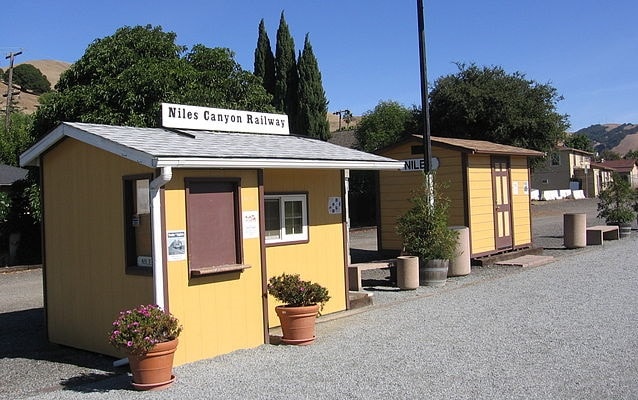Last updated: June 1, 2018
Place
Niles Canyon Transcontinental Railroad Historic District

Photo taken by Pedro Xing, CC0
The Niles Canyon Transcontinental Railroad Historic District is made up of the 11 mile-long section of the First Transcontinental Railroad that passes through Niles Canyon between the towns of Sunol and Fremont (Niles), north of San Jose, California. The rail line through Niles Canyon to San Francisco was the final segment of the First Transcontinental Railroad and was completed in 1870, providing the first rail connection between the San Francisco Bay area and the rest of the United States. The companies that constructed the far western portion of the railroad employed thousands of Chinese laborers, and its completion is considered one of the most significant engineering achievements of the 19th century.
The First Transcontinental Railroad connected the San Francisco Bay Area to existing rail lines in the Midwest and East. The section of the railroad from San Francisco to Sacramento was built primarily by two companies, the Central Pacific Railroad Corporation (CPRR), and the Western Pacific Railroad Company (WPCR). Initially, the railroads had trouble attracting workers as people felt they could make money more quickly with less danger by working in mines like those on the Comstock Lode in Virginia City, Nevada. The WPCR supplemented its workforce with Chinese laborers and this proved so successful that the CPRR began to recruit Chinese workers from immigrant communities within the U.S. and later directly from China. The CPRR eventually employed over 11,000 Chinese immigrants to construct its portion of the First Transcontinental Railroad, accounting for 90 percent of its workforce.
The WPCR built 20 miles of track between Sacramento and San Jose, reaching Alameda Cañon (Niles Canyon) in 1866. The WPCR used 500 Chinese laborers to grade and construct the rail line into the rugged canyon with its tight curves and narrow banks. Construction was then halted because of disagreements between the railroad’s contractors and its financiers. In late 1869, the CPRR, which had bought the WPCR, restarted work on the railroad through Alameda Cañon, also using Chinese labor. Besides grading the railroad bed, the laborers built culverts, retaining walls, and bridge piers. Four major timber through (Howe) truss bridges were built to cross Alameda Creek and Arroyo de la Laguna Creek. By early 1870, the last section of the First Transcontinental Railroad, through Niles Canyon to the San Francisco Bay, was complete.
In 1880, the rail line through Niles Canyon became secondary to a new main line constructed through the towns of Benicia and Martinez, California. In 1889, the CPRR became a subsidiary of the Southern Pacific Railway and the two merged in 1959. The tracks through Niles Canyon were in service until 1984 when Southern Pacific deeded the section of the rail line from Sunol to Fremont (Niles), the associated structures, and the right-of-way to Alameda County.
In 1987, the Pacific Locomotive Association entered into an agreement with Alameda County and in 1988, began operating passenger cars along the Niles Canyon Railway. Today, the Pacific Locomotive Association operates the historic Niles Canyon Railway as a living history museum and runs both diesel and steam locomotives through the canyon on Sundays from February through October.
The Niles Canyon Transcontinental Railroad is one of the best preserved segments of the First Transcontinental Railroad in the western U.S. and is one of the only examples of a mainline railroad in the West to retain most of its features from the 19th and early 20th centuries. The narrow railroad bed and sharp turns are characteristic of the early years of railway construction in the U.S. Most similar roadbeds were obliterated as railroads began to modernize beginning in the 1890s. The ruggedness of Niles Canyon limited efforts to improve the roadbed and it has remained essentially unaltered except for bridge replacements and the addition of passing sidings and signals. As a result, many of the views through the canyon remain pristine and the tracks are still on the original alignment that Chinese workers graded in the 1860s. Today, Niles Canyon is the only remaining railroad corridor entering the San Francisco Bay area that has not been substantially altered for modern transportation projects.
Niles Canyon Transcontinental Railroad Historic District is located between the towns of Sunol and (Niles) Fremont, California.
